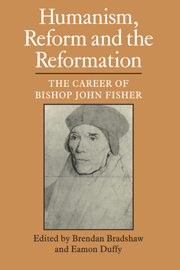Book contents
- Frontmatter
- Contents
- Preface
- List of abbreviations
- Bishop John Fisher, 1469–1535: the man and his work
- John Fisher and the promotion of learning
- The University chancellor
- The bishop in his diocese
- Fisher and Erasmus
- Fisher and More: a note
- The polemical theologian
- Fisher's view of the Church
- Fisher, Henry VIII and the Reformation crisis
- Royal ecclesiastical supremacy
- The spirituality of John Fisher
- Appendixes
- Index
The University chancellor
Published online by Cambridge University Press: 04 August 2010
- Frontmatter
- Contents
- Preface
- List of abbreviations
- Bishop John Fisher, 1469–1535: the man and his work
- John Fisher and the promotion of learning
- The University chancellor
- The bishop in his diocese
- Fisher and Erasmus
- Fisher and More: a note
- The polemical theologian
- Fisher's view of the Church
- Fisher, Henry VIII and the Reformation crisis
- Royal ecclesiastical supremacy
- The spirituality of John Fisher
- Appendixes
- Index
Summary
Between 1440 and 1550 Cambridge became a collegiate University: the centre of gravity in the teaching passed into the colleges, and the academic quarter, the special beauty of Cambridge – which stretches from Peterhouse and Queens’ in the south to St John's in the north – was completed. It owed much to the fourteenth-century founders who had grouped Clare and Trinity Hall and Gonville Hall round the Old Schools – with other foundations not far away; it was completed by the landscape gardeners between the sixteenth and the eighteenth centuries who created the Backs, and canonised when Capability Brown laid out the Fellows’ Garden at St John's and when his scheme to turn the rest of the Backs into a park was rejected. But the special and peculiar beauty of the academic quarter of Cambridge for many of us lies in the old red-brick courts set at the southern end by Andrew Doket, founder of Queens’, and at the northern by John Fisher, founder of John's.
It is common form to attribute Queens’ to Queen Margaret of Anjou encouraged by her husband, Henry VI, and John's to the Lady Margaret Beaufort; quite rightly, for without their interest and their patronage the foundations could never have occurred. It is particularly the case that the Lady Margaret and Fisher are inseparable in their foundations, as Malcolm Underwood has shown in his penetrating studies of their work.
- Type
- Chapter
- Information
- Humanism, Reform and the ReformationThe Career of Bishop John Fisher, pp. 47 - 66Publisher: Cambridge University PressPrint publication year: 1989



